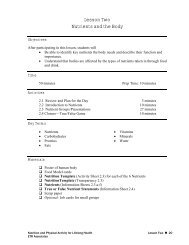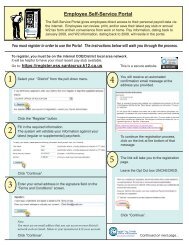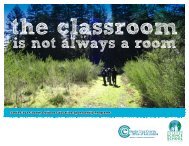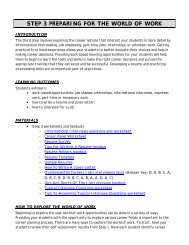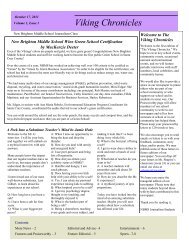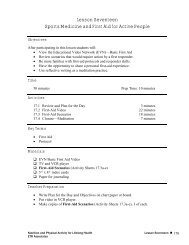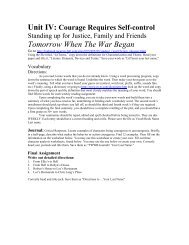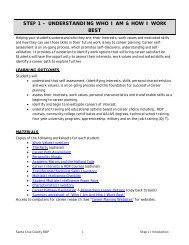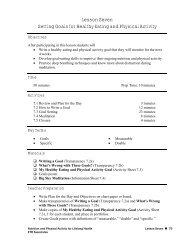Lesson 5 - Physical Education for Body, Mind and Spirit
Lesson 5 - Physical Education for Body, Mind and Spirit
Lesson 5 - Physical Education for Body, Mind and Spirit
- No tags were found...
Create successful ePaper yourself
Turn your PDF publications into a flip-book with our unique Google optimized e-Paper software.
<strong>Lesson</strong> FiveCalorie IntakeObjectivesAfter participating in this lesson students will• Know how many calories per day are appropriate <strong>for</strong> them to eat based on theiractivity level, age <strong>and</strong> gender.• Have developed a menu <strong>for</strong> the day based on their calorie per dayrecommendation.TimeActivitiesKey TermsMaterials50 minutes Prep Time: 20 minutes5.1 Review <strong>and</strong> Plan <strong>for</strong> the Day 3 minutes5.2 Nutrition Facts <strong>for</strong> YO! 10 minutes5.3 Calories in a Day 32 minutes5.4 Closure 5 minutes• Activity Level What Do We Know? poster Nutrition Facts <strong>for</strong> YO! (Activity Sheet 5.2) My Pyramid Food Intake Pattern (In<strong>for</strong>mation Sheet 5.3) Highlighters Food Model cards Masking tape Calculators Me <strong>and</strong> My Calories (Activity Sheet 5.4)Teacher Preparation• Write Plan <strong>for</strong> the Day <strong>and</strong> Objectives on chart paper or board.• Make copies of Nutrition Facts <strong>for</strong> YO! (Activity Sheet 5.2), 1 <strong>for</strong> each student,<strong>and</strong> place in portfolios.• Make copies of My Pyramid Food Intake Pattern (In<strong>for</strong>mation Sheet 5.3), 1 <strong>for</strong>each student, <strong>and</strong> place in portfolios.Nutrition <strong>and</strong> <strong>Physical</strong> Activity <strong>for</strong> Lifelong Health <strong>Lesson</strong> Five • 61ETR Associates
• Create Calories in a Day chart. (See Activity 5.3.)• Separate Food Model cards by Food Groups.• Make copies of Me <strong>and</strong> My Calories (Activity Sheet 5.4), 1 <strong>for</strong> each student, <strong>and</strong>place in portfolios.5.1 Review <strong>and</strong> Plan <strong>for</strong> the Day 3 minutesMaterials: Plan <strong>for</strong> the Day <strong>and</strong> Objectives, What Do We Know? posterWrite the Plan <strong>for</strong> the Day <strong>and</strong> Objectives on the board be<strong>for</strong>e class, listing all of theactivities students will be doing.Plan <strong>for</strong> the Day:• Nutrition Facts <strong>for</strong> YO!• Calories in a Day• ClosureReview the previous class by looking over the What Do We Know? poster. Reiterate thewords variety, balance <strong>and</strong> moderation by writing those words next to the definition of thatword, as follows:• Eat foods from all food groups. (BALANCE)• Eat a variety of foods from each food group to get all the nutrients.(VARIETY)• Monitor the size of a portion of food. (MODERATION)Explain that today students will find out how many calories a day they should consumeindividually <strong>and</strong>, based on that in<strong>for</strong>mation, come up with a menu <strong>for</strong> a day with theappropriate number of calories.Review the Objectives with students.5.2 Nutrition Facts <strong>for</strong> YO! 10 minutesMaterials: Nutrition Facts <strong>for</strong> YO! (Activity Sheet 5.2), My Pyramid Food IntakePattern (In<strong>for</strong>mation Sheet 5.3), highlighters, student portfolios• Explain that we find the amount of calories we need according to our activity level(amount of physical activity you do in a day), age <strong>and</strong> gender.• Show students the Nutrition Facts <strong>for</strong> YO! activity sheet in their portfolios. Readthrough the steps as a class be<strong>for</strong>e they fill it out. Then, have the students fill in the“How do you make your moves?” section based on what they think their activity levelis overall. Walk around <strong>and</strong> help students if they are unsure of their activity level.• Once students have completed that section, move down to the section titled,“Calories—How many <strong>for</strong> you?” <strong>and</strong> have them use the table to determine theirNutrition <strong>and</strong> <strong>Physical</strong> Activity <strong>for</strong> Lifelong Health <strong>Lesson</strong> Five • 62ETR Associates
calorie level based on gender <strong>and</strong> age. Explain that the calorie level given is <strong>for</strong>people whose activity level is “On-the-Move.” If their activity level is “S-l-o-w Mo”they need to subtract 200 calories, <strong>and</strong> if they are a “Real Mover” they need to add200 calories. (Note: To help students who need a visual aid, make a transparency ofthe Nutrition Facts <strong>for</strong> YO! activity sheet to read from.)• Once all students have found their calorie level, have them look at the My PyramidFood Intake Pattern in<strong>for</strong>mation sheet. Direct students’ attention to the sectionlabeled “Suggested Daily Amount of Food From Each Group.” It has several calorielevels with how much food from each group should be consumed in a day. Havethem highlight their calorie amount <strong>and</strong> the amount of servings they should eat fromeach food group.• Explain that knowing their calorie level <strong>and</strong> how much from each food group toconsume, will allow them to come up with a menu <strong>for</strong> a day based on thispersonalized in<strong>for</strong>mation.5.3 Calories in a Day 32 minutesMaterials: Food Model cards, My Pyramid Food Intake Pattern (In<strong>for</strong>mation Sheet 5.3),chart paper, masking tape, markers, Calories in a Day chart written out <strong>for</strong> demonstrationBased on the in<strong>for</strong>mation they find out on the My Pyramid Food Intake Patternin<strong>for</strong>mation sheet, explain to students that they are going to design a menu <strong>for</strong> themselves <strong>for</strong>a day based on their calorie expenditure <strong>and</strong> cups or ounces <strong>for</strong> each food group.• Ask students to find another person in the room who has the same calorie level. Theywill be working with that person to create a menu <strong>for</strong> the day. Give students anopportunity to find a partner to work with. If students can’t find someone with theexact same calorie level they can work with someone who is within a 200 caloriedifference.• Show the students the Calories in a Day chart <strong>and</strong> explain the in<strong>for</strong>mation that is tobe written on the chart:Calories in a Day (title)• Total Calorie Level• Breakfast, Snack, Lunch, Snack, Dinner• Calorie Consumption <strong>for</strong> each meal.• Show students the Food Model cards to use. Show the back of the card so studentssee where to get total calorie amounts <strong>for</strong> that food item. Explain that if they cannotfind a food card or someone else is using a card they want to use, then they can writethe name of the food <strong>and</strong> its calorie level on their chart.Nutrition <strong>and</strong> <strong>Physical</strong> Activity <strong>for</strong> Lifelong Health <strong>Lesson</strong> Five • 63ETR Associates
• Give each pair a piece of chart paper, tape <strong>and</strong> markers. Have them chart their menu<strong>for</strong> the day to equal the appropriate number of calories <strong>and</strong> to provide balance/varietyof nutrients/food groups.• Once students have completed their chart, have them hang it up. Ask what are somethings they learned from doing this activity. Ask specifically if they were surprisedby the amount of food they put on their chart to meet their calorie requirement.Emphasize the different amount of foods needed <strong>for</strong> different calorie levels. Finally,reiterate balance, variety <strong>and</strong> moderation using different students’ charts <strong>and</strong>showing how they addressed those concepts.5.4 Closure 5 minutesMaterials: Me <strong>and</strong> My Calories (Activity Sheet 5.4)Have students turn to the Me <strong>and</strong> My Calories activity sheet in their portfolios.• Review the 2 questions with students: Why is it important to eat all the daily caloriesyou are supposed to? <strong>and</strong> Why would a girl who exercises 3 times a week consume adifferent amount of calories than a boy who exercises 3 times a week?(Answers: It is important to get all of your calories so that you are getting all of yournutrients <strong>and</strong> energy. The difference between calorie intake <strong>for</strong> a boy <strong>and</strong> a girl could be dueto the person’s age <strong>and</strong> the body composition difference between males <strong>and</strong> females.)• Give students 3 minutes to write down their answers <strong>and</strong> then take 2 minutes to goover the correct responses. Have students adjust their answers as needed.Resourceswww.mypyramid.gov/downloads/MyPyramid_Food_Intake_Patterns.pdfActivity 5.3 Calories in a Day: from All 4 You 2! curriculum, <strong>Lesson</strong> 5, Activity 3Worksheet <strong>for</strong> Activity 5.2: http://ific.org/publications/other/tnfl.cfmNutrition <strong>and</strong> <strong>Physical</strong> Activity <strong>for</strong> Lifelong Health <strong>Lesson</strong> Five • 64ETR Associates
Activity Sheet 5.2Reprinted from the International Food In<strong>for</strong>mation Council Foundation, Department of Health & HumanServices <strong>and</strong> U.S. Food & Drug Administration (July 1994).Nutrition <strong>and</strong> <strong>Physical</strong> Activity <strong>for</strong> Lifelong Health <strong>Lesson</strong> Five • 65ETR Associates
In<strong>for</strong>mation Sheet 5.3My Pyramid Food Intake PatternThe suggested amounts of food to consume from the basic food groups, subgroups, <strong>and</strong> oils to meetrecommended nutrient intakes at 12 different calorie levels.Suggested Daily Amount of Food from Each Group1. Calorie Level1 1,000 1,200 1,400 1,600 1,800 2,000 2,200 2,400 2,600 2,800 3,000 3,2002. Fruits2 1 cup 1 cup1.5cups1.5cups1.5cups2cups2cups2cups2cups2.5cups2.5cups2.5cups3. Vegetables3 1 cup1.5cups1.5cups2cups2.5cups2.5cups3cups3cups3.5cps3.5cups4 cups4cups4. Grains4 3 oz 4 oz 5 oz 5 oz 6 oz 6 oz 7 oz 8 oz 9 oz 10 oz 10 oz 10 oz5. Meat <strong>and</strong>Beans52 oz 3 oz 4 oz 5 oz 5 oz 5.5 oz 6 oz 6.5 oz 6.5 oz 7 oz 7 oz 7 oz6. Milk62cups2cups2cups3cups3cups3cups3cups3cups3cups3 cups 3 cups 3 cups7. Oils7 3 tsp 4 tsp 4 tsp 5 tsp 5 tsp 6 tsp 6 tsp 7 tsp 8 tsp 8 tsp 10 tsp 11 tsp8. Discretionarycalorieallowance8165 171 171 132 195 267 290 362 410 426 512 6481. Calorie Levels are set across a wide range to accommodate the needs of different individuals.2. Fruits Group includes all fresh, frozen, canned <strong>and</strong> dried fruits <strong>and</strong> fruit juices. In general, 1 cup of fruitor 100% fruit juice, or 1/2 cup of dried fruit can be considered as 1 cup from the fruit group.3. Vegetables Group includes all fresh, frozen, canned <strong>and</strong> dried vegetables <strong>and</strong> vegetable juices. Ingeneral, 1 cup of raw or cooked vegetables or vegetable juice, or 2 cups of raw leafy greens can beconsidered as 1 cup from the vegetable group.4. Grains Group includes all foods made from wheat, rice, oats, cornmeal <strong>and</strong> barley, such as bread,pasta, oatmeal, breakfast cereals, tortillas <strong>and</strong> grits. In general, 1 slice of bread, 1 cup of ready-to-eatcereal, or 1/2 cup of cooked rice, pasta or cooked cereal can be considered as 1 ounce equivalent from thegrains group. At least half of all grains consumed should be whole grains.5. Meat <strong>and</strong> Beans Group. In general, 1 ounce of lean meat, poultry or fish, 1 egg, 1 Tbsp. peanut butter,1/4 cup cooked dry beans, or 1/2 ounce of nuts or seeds can be considered as 1 ounce equivalent from themeat <strong>and</strong> beans group.6. Milk Group includes all fluid milk products <strong>and</strong> foods made from milk that retain their calcium content,such as yogurt <strong>and</strong> cheese. Foods made from milk that have little to no calcium, such as cream cheese,cream <strong>and</strong> butter, are not part of the group. Most milk group choices should be fat-free or low-fat. Ingeneral, 1 cup of milk or yogurt, 1-1/2 ounces of natural cheese, or 2 ounces of processed cheese can beconsidered as 1 cup from the milk group.7. Oils include fats from many different plants <strong>and</strong> from fish that are liquid at room temperature, such ascanola, corn, olive, soybean <strong>and</strong> sunflower oil. Some foods are naturally high in oils, such as nuts, olives,some fish <strong>and</strong> avocados. Foods that are mainly oil include mayonnaise, certain salad dressings <strong>and</strong> softmargarine.8. Discretionary Calorie Allowance is the remaining amount of calories in a food intake pattern afteraccounting <strong>for</strong> the calories needed <strong>for</strong> all food groups—using <strong>for</strong>ms of foods that are fat-free or low-fat <strong>and</strong>with no added sugars.Nutrition <strong>and</strong> <strong>Physical</strong> Activity <strong>for</strong> Lifelong Health <strong>Lesson</strong> Five • 66ETR Associates
Activity Sheet 5.4Me <strong>and</strong> My Calories1. Why is it important to eat all the daily calories you aresupposed to?2. Why would a girl who exercises 3 times a week consume adifferent amount of calories than a boy who exercises 3 timesa week?Nutrition <strong>and</strong> <strong>Physical</strong> Activity <strong>for</strong> Lifelong Health <strong>Lesson</strong> Five • 67ETR Associates



